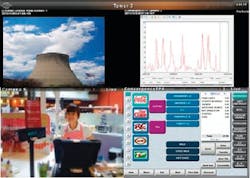The next technology wave in the video surveillance market is fast approaching as video becomes the head end for all IP-enabled appliances and sensors in the customer’s enterprise. The migration path is inevitable, as you already have the video surveillance infrastructure, bandwidth, network connectivity and trained personnel to lead this technology consolidation.
The video surveillance system is the most reliant component in the enterprise network for analyzing and storing the massive amounts of data that will be received as these technologies consolidate into a single head-end monitoring and management topology. Network appliances, such as video surveillance, access control, license plate recognition, asset tracking and point-of-sale terminals, along with IP sensors, such as PLC controllers and RFID tags, are now critical components of a new era of smart systems and businesses. Technology users realize that in order to truly have real-time awareness and response in their enterprise that all of their network devices and appliances need to be connected and have access to any and all video.
Forward-thinking technology users realize that all this collective awareness made possible by information downloads from their IP devices is far greater than just the sum of the individual parts. What we are now seeing is a migration from personnel multipliers to technology multipliers. Alerts are being accompanied by procedures unique to the events, which have been spelled out by the end user’s specific needs. With the event information and synchronized video displayed on the same screen, security personnel have the tools necessary to properly assess situations and immediately respond in a proper manner.
Creating a Unified Security Platform (USP) doesn’t imply that you combine your set-up, credentialing rules and configuration settings into the command center. However, you do need to include the operational features and benefits these IP appliances provide, which can include pushing critical alert messages from the appliances to the command and control center.
Having alert information stored with your video provides tremendous advantages, since security personnel are able to access all recorded events from every appliance, and can access the recorded video from the recording servers in the control console - in a command center that is manned 24/7 by trained staff. The advent of alert-triggered video surveillance moves security beyond the limits of simply monitoring doorways equipped with an access control system; it ensures access to any camera view within the network with time synchronized event playback capabilities. Using a USP-driven approach enables security personnel to employ one operational system that has a familiar look and feel – and it is the system they already own. There is no new operator training required for the various IP appliance alerts, because the real-time metadata from these device comes through the VMS as a camera stream.
An embedded search engine in the USP will use Boolean expressions allowing it to drill down multiple levels to specific events, using either broad term to find events such as contains, or specific terms such as equal to, applied to the metadata packet. For example, for LPR the operator could search using only a partial plate number, combining that with a lane number or state, which could access all license plates meeting that search criteria during a specific date and time.
This search can be done in just a few seconds from the command center console. If you had an exact plate number, by using the” equal to” operator, the search engine could access every video displaying that specific plate each time it corresponded with the specific date and time. The rules engine can also be set up to detect unregistered plates for unregistered vehicles entering the campus. This feature can save time during heavy traffic periods, allowing campus security to clear registered vehicles free passage and concentrate on those that are in violation.
Having access to all the recorded video also enables campus security to search other camera views so the operator can piece together the vehicle’s travel path from initial detection or prior to detection. When the USP is used in conjunction with an access control system, it can provide an accurate and time-stamped audit trail of building activity and door access
It is important to note that an IP appliance can be any device, including:
- Point-of-Sale terminals- used for retail transactions involving no sales, refunds or voids
- Access control systems -- used for building entry or building monitoring systems
- Asset tracking systems – used for shipping and receiving at loading docks, intercepting important packages, or identifying merchandise re-calls at the loading dock
- Banking transactions -- it can be either ATM machines or teller workstation transactions to resolve customer disputes on the spot
- Manufacturing operations -- used to monitor assembly lines in alert mode for rejected parts or sending a status of completed parts. The alert information could also be incorporated into real-time charting by monitoring specific events and when they hit a user-defined threshold, then pushing a chart to the client alerting the console operator.
In addition to the event notifications, users can establish their own procedures and have them pushed to the command center to alert security personnel of pre-defined events and provide them with on-screen instructions. The procedure may reference a company-wide policy in an emergency situation, which instructs operators to follow a pre-determined priority call tree. Or it can be a simple event such as a door forced open or a combination of events, such as a cashier fraudulently entering a no sale at the cash register, prompting the operator to notify management. In conjunction with the alert, a text message could be sent alerting the store manager of this no sale, allowing him to call up his mobile video to see if a customer was actually present at the register when this refund was being transacted.
Possessing IP appliance alerts, tightly meshed with a video surveillance system, offers more visibility for your security operations. It also helps security personnel manage the system more efficiently by using many of the assets already in place, including the trained manned personnel. This consolidation of technology, information and personnel equates to a bona fide Unified Security Platform.
About the Author: Charles Hickey PSP, is director of operations for ConvergenceTP, a technology leader in IP appliance connectivity to video management systems. The heart of its system is its patent pending Event Streaming Engine (ESE). The ESE design is optimized to provide a seamless interface for IP appliance TCP/IP text that can be streamed directly into the Video Management System as a camera stream. The ESE Text-To-Video software and Event-to-Video search tools sit between the IP appliance and the VMS, thereby providing a common interface (video) to the VMS for all attached IP appliances. Interfaces include POS, RFID, Access Control, LPR, ATM, etc. ConvergenceTP (North Haven, CT ) was founded in 2010.


